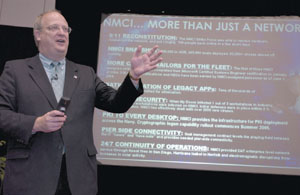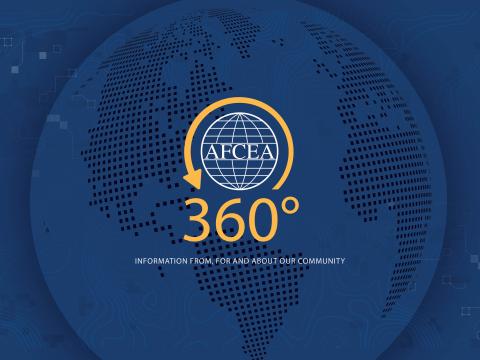Tough Love Greets Military Transformers
 |
| David Wennergren, chief information officer for the Navy, tells success stories to Transformation TechNet 2005 attendees. |
The defense community’s annual transformation-focused meeting offered a reality check for those working to more fully integrate the
Before anyone could tout the
To demonstrate his point, the general offered a threat scenario involving a suspicious ship’s approach to a metropolitan port. Using slides previously generated by a Swedish visualization tool, Bergh showed how a Web-interfaced, service-oriented system allowed military and civilian officials to track the ship, and how their coordinated actions deterred its entrance into the port.
Swedish officials currently are testing the system’s command and control capabilities and will begin scrutinizing implementation methodology in 2006, he said. Gen. Bergh’s speech seemed to validate the idea of leveraging information sharing and collaboration and highlighted the Swedish military’s strong partnership with the industry that supports it.
A later panel discussion underscored the
JFCOM currently has two CRADAs underway, five more probable candidates, and three still in the exploratory stage.
“We don’t need new models. We need better implementation of the models we have,” panelist Maj. Gen. Timothy A. Peppe, USAF (Ret.), fired off. Now president of the National Defense Industrial Association Greater Hampton Roads Chapter, Gen. Peppe rifled down a laundry list of industry officials’ stated grievances against JFCOM: closed off, not industry-friendly, cumbersome and not timely. He punctuated his constituency’s frustrations by telling Richards that JFCOM “allows ideas to die on the vine.” Gen. Peppe added, “There’s nothing worse to a science guy than presenting an idea and never hearing back peep one.” He urged JFCOM officials to provide more guidance to industry. “If it’s there, I’ve missed it,” he said pointedly.
Gen. Peppe further scolded defense officials for restricting who can access “lessons learned” reports emanating from operations in
“I did ask [Peppe] to be brutally honest, JFCOM’s Richards said. “And he was.”
Capt. Ray Rodriguez, USN, a JFCOM business manager, joked that he should have taken advice to don a protective vest before sitting on the panel. “I’m bleeding pretty heavily,” he quipped.
And Capt. Rodriguez’ review of JFCOM’s attempts to engage industry only seemed to pour salt into the wounds. The command initiated a series of industry-invited events to target solutions toward specific JFCOM needs. But the ill-named Focus Forums lacked focus, reported Capt. Rodriguez. “We were all over the board,” he said. Of the initiatives presented at the command’s initial network-centric operations forum, few were pursued, he added.
But the command may improve relations by adopting a model used by the U.S. Army Training and Doctrine Command (TRADOC). The command publishes a request for information based on a collective list of top Army interests, Capt. Rodriguez said, and responds to every company that provides ideas. Then, about once a month, TRADOC selects a company to discuss its solution. The winning ideas are subsequently connected with an interested party such as an Army command, he added.
If TRADOC’s example of success provided lift to JFCOM’s sinking attempts to turn ideas into reality, the U.S. Navy’s chief storyteller further buoyed attendees with tales of real-world success. Dave Wennergren, the Navy’s chief information officer, energetically began his luncheon speech with a blur of examples highlighting Navy network-centric victories. High on Wennergren’s “atta-boy” list is the Navy/Marine Corps Intranet (NMCI), which consolidated hundreds of disparate and localized networks into a single integrated one. “It’s a truly transformational intranet,” he said. NMCI’s creation had the unexpected effect of helping the Navy identify disparate applications built by local units, Wennergren said. “They’re all great solutions, but we can’t afford to have duplicative systems,” he added.
Wennergren also pointed to the Navy’s Common Access Card (CAC) Public Key Infrastructure (PKI) program as a model for transformation. The personal identification technology is providing millions of service members, civilians and eligible contractors with secure access to the Navy’s network services as well as to private Web sites.
A subsequent panel discussion on technology delivery tempered Wennergren’s motivating wave of Navy successes. Moderator Dr. Janet S. Fender, chief scientist, Air Combat Command (ACC), warned that technology that passes specifications still might not be effective. She advised pursuing capability-based solutions built through strong partnerships between industry and the military.
Panelist Maj. Gen. Donald F. Hoffman, USAF, who directs requirements for the Air Force’s ACC Headquarters, agreed. “Use-and-abuse tests are different from lab testing,” Gen. Hoffman said. He urged patience when implementing new technologies, saying it takes time for them to work. But the meat of Gen. Hoffman’s remarks focused on providing more flexible acquisition options. “We tend to paint acquisition with the same brush,” the general said. Costly and complex technologies might take longer to acquire, but small assisting technologies can be fielded rapidly, Gen. Hoffman suggested. His command solicits new ideas every two years. “It’s tough for a new seed to grow on a dry, barren landscape,” the general said.
Three industry panelists added to Hoffman’s remarks. Dr. Dennis Govoni, chief technology officer, Sun Microsystems–Sun Federal, said sensors are providing the ability to collect data in real time. But the challenge, he said, is to know which sensors are critical. Weather sensors can probably skip a deadline, but sensors tracking incoming missiles obviously cannot, Govoni said. Emerging data virtualization technology, which makes it possible to view data from disparate sources without knowing where the data actually resides, will help in prioritizing that type of information, he added.
Raytheon Corporation technologist Allan Mattson tantalized the panel audience with a technology straight out of
The final panelist, Col. Jose Negron, USAF (Ret.), related how effects-based operations can produce quick technology delivery. He offered unmanned aerial vehicle (UAV) technology as a prime example. “We cannot get UAVs off the shelf fast enough,” said Col. Negron, who now works as a military consultant for SRS Technologies Incorporated.
The conference’s second day brought new transformation perspectives. Lt. Gen. William M. Fraser III, USAF, vice commander, ACC, told a breakfast crowd that everyone is involved in building the battle command picture. He highlighted the ongoing integration between services, pointing to the refitting of Army Stryker vehicles with Air Force Tactical Air Control Party (TACP) capabilities. The fusion connects ground forces to air combat power.
During a later panel discussion, Kenneth S. Callicutt, senior technical director, Air Force Command and Control and Intelligence, Surveillance and
Panelist Col. Phillip R. Speake,
Lt. Cmdr. Danelle Barrett, USN, communications officer, Commander Carrier Strike Group Twelve, touted the Navy’s efforts to integrate warfighting. The Navy is working on an in-theater convoy registration system that would reduce attacks on vehicles by requiring all field commanders to register convoys. The system would fill empty seats and reduce convoy traffic along dangerous routes, Cmdr. Barrett said.
Closing speaker David J. Ozolek, who directs JFCOM’s Joint Futures Laboratory, left attendees with a vision of the future through the window of past events. He used the
He emphasized that while single-point command decision making will remain unchanged, control will continue to evolve. The
Offering a real-world example of the military’s growing integration, Ozolek shared the story of a strategically oriented Air Force B-52 bomber providing tactical close air support to assist a special forces operative on horseback during a recent operation. Perhaps, Ozolek’s example seems to indicate,
AFCEA International and its Hampton Roads and Tidewater chapters sponsored the event.
 | Maj. Gen. Svante Bergh, Swedish Army (Ret.), visits with an exhibitor. |
 | David J. Ozolek, executive director, Joint Futures Laboratory, told attendees that the military is evolving from deconfliction to interdependence. |
 | Dr. Janet S. Fender, chief scientist, Air Combat Command, moderates a panel on technology delivery. |
 | Lt. Cmdr. Danelle Barrett (r) USN, communications officer, Commander Carrier Strike Group Twelve, addresses technology delivery issues while the Army's Col. Phillip R. Speake awaits his turn. |




Comments